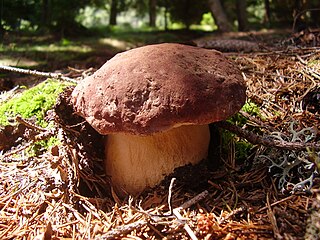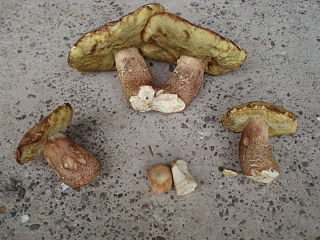
Neoboletus luridiformis, also previously known as Boletus luridiformis and (invalidly) as Boletus erythropus, is a fungus of the bolete family, all of which produce mushrooms with tubes and pores beneath their caps. It is found in Northern Europe and North America, and is commonly known as the scarletina bolete, for its red pores, which are yellow when young. Other common names include the red foot bolete, dotted stemmed bolete, or dotted stem bolete.

Boletus pinophilus, commonly known as the pine bolete or pinewood king bolete, is a basidiomycete fungus of the genus Boletus found throughout Europe and western Asia. Described by Italian naturalist Carlo Vittadini in 1835, B. pinophilus was for many years considered a subspecies or form of the porcini mushroom B. edulis before genetic studies confirmed its distinct status. In 2008, B. pinophilus in western North America were reclassified as a new species, B. rex-veris. B. pinophilus is edible, and may be preserved and cooked.

Boletellus obscurecoccineus, known as the rhubarb bolete, is a species of fungus in the family Boletaceae, found in Australia, New Guinea, Java, Borneo, Japan, Korea, and Taiwan. It is a distinctive and colourful bolete of the forest floor.

Butyriboletus appendiculatus is an edible pored mushroom that grows under oaks and other broad leaved trees such as beech. It is commonly known as the butter bolete. It often grows in large colonies beneath the oak trees, and is frequently found cohabiting with old oaks in ancient woodland. It is relatively rare in Britain. Its stipe and pores are often bright yellow and its flesh stains bright blue when cut or bruised.

Boletus regineus, commonly known as the queen bolete, is an edible and highly regarded fungus of the genus Boletus that inhabits southwestern North America. It was considered a variant of the similarly edible B. edulis for many years until declared a unique species in 2008. Phylogenetic analysis has shown B. regineus as a member of a clade, or closely related group, with B. subcaerulescens, Gastroboletus subalpinus, B. pinophilus, B. fibrillosus, and B. rex-veris.

Tylopilus plumbeoviolaceus, commonly known as the violet-grey bolete, is a fungus of the bolete family. First described in 1936, the mushroom has a disjunct distribution, and is distributed in eastern North America and Korea. The fruit bodies of the fungus are violet when young, but fade into a chocolate brown color when mature. They are solid and relatively large—cap diameter up to 15 cm (5.9 in), with a white pore surface that later turns pink, and a white mycelium at the base of the stem. The mushroom is inedible. A number of natural products have been identified from the fruit bodies, including unique chemical derivatives of ergosterol, a fungal sterol.

Butyriboletus regius, commonly known as the royal bolete or red-capped butter bolete, is a basidiomycete fungus of the genus Butyriboletus found in China and Europe. B. regius has a pink cap, yellow flesh, and a reticulate pattern on the stem. Harry D. Thiers described a similar mushroom from California as B. regius, though it is not the same species. B. regius in Europe does not stain when exposed to air, or stains weakly, but the California species stains blue. Both European and California species are considered choice edibles.

Boletus subcaerulescens is a basidiomycete fungus of the genus Boletus found in northeastern North America. The fruiting bodies are found associated with pine and spruce. The cap is up to 18 cm wide, convex to flat, and brown in color. The tubes are yellow and stain blue when bruised, while the flesh is white to buff and does not stain when cut. The stem is brown like the cap and has a light-colored reticulate texture.

Tylopilus alboater, called the black velvet bolete, by some, is a bolete fungus in the family Boletaceae. The species is found in North America east of the Rocky Mountains, and in eastern Asia, including China, Japan, Taiwan, and Thailand. A mycorrhizal species, it grows solitarily, scattered, or in groups on the ground usually under deciduous trees, particularly oak, although it has been recorded from deciduous, coniferous, and mixed forests.

Boletus curtisii is a species of fungus in the family Boletaceae. It produces small- to medium-sized fruit bodies (mushrooms) with a convex cap up to 9.5 cm (3.7 in) wide atop a slender stem that can reach a length of 12 cm (4.7 in). In young specimens, the cap and stem are bright golden yellow, although the color dulls to brownish when old. Both the stem and cap are slimy or sticky when young. On the underside of the cap are small circular to angular pores. The mushroom is edible, but not appealing. It is found in eastern and southern North America, where it grows in a mycorrhizal association with hardwood and conifer trees. Once classified as a species of Pulveroboletus, the yellow color of B. curtisii is a result of pigments chemically distinct from those responsible for the yellow coloring of Pulveroboletus.

Boletus abruptibulbus is a species of bolete mushroom in the family Boletaceae. Described as new to science in 2009, it is found only in the Gulf Coast of the Florida Panhandle, where it grows on the ground in coastal sand dunes, one of only three North American boletes known to favor this habitat. The fruit bodies have convex brownish caps up to 8 cm (3.1 in) in diameter, supported by solid yellowish to reddish stems measuring 3–5 cm (1.2–2.0 in) long by 10–15 mm (0.4–0.6 in) thick. The pores on the underside of the cap measure about 1–2 mm in diameter and are initially pale yellow before developing a greenish tinge in age. The mushroom's spores, about 20 micrometers long, are unusually long for a member of the Boletaceae. The stem base is bulbous, a diagnostic feature for which the species is named.

Aureoboletus auriflammeus, commonly known as the flaming gold bolete, is a species of bolete fungus in the family Boletaceae. Described as new to science in 1872, it is found in eastern North America, where it grows in a mycorrhizal association with oaks. The caps of the fruit bodies are golden orange, with a yellow pore surface on the underside, and a reticulated (network-like) stem. The edibility of the mushroom is not known.

Butyriboletus is a genus of fungi in the family Boletaceae. The genus was circumscribed in 2014 by mycologists David Arora and Jonathan L. Frank to accommodate "butter bolete" species that were shown by molecular analysis to be phylogenetically distinct from Boletus. Butyriboletus contains 24 ectomycorrhizal species found in Asia, Europe, North America and north Africa.

Lanmaoa fragrans is a rare species of bolete fungus in the family Boletaceae found in Europe. It has a brownish convex cap measuring 5–12 cm (2.0–4.7 in) in diameter that initially has a velvety texture before becoming smooth. The spindle-shaped stipe measures 7–9 cm (2.8–3.5 in) long by 3–5 cm (1.2–2.0 in) wide. It is yellow at the top and flushed with red in the lower portions, terminating with black at the very base. The yellow flesh is tinged with red under the cap cuticle. It bruises blue only after several hours of exposure to air. The pores on the cap underside are lemon-yellow to chrome-yellow and display a faint blue bruising reaction. Spores are elliptical and measure 9–14 by 4.5–6.5 µm; in mass they produce an olive-green spore print.

Boletus nobilissimus is an edible basidiomycete mushroom, of the genus Boletus in the family Boletaceae. Long considered a variety of European Boletus edulis, it has become a species on its own in 2000, with 2010 molecular study finding that it is most closely related to B. atkinsonii, B. quercophilus of Costa Rica and then B. barrowsii of western United States. It is found in abundance in open oak forests after heavy rains and warm weather.
Boletus sinoedulis is an edible basidiomycete mushroom, of the genus Boletus in the family Boletaceae. Morphologically similar to Boletus edulis and belonging to the porcini group, it was first described in 2015, and is known to be found only in China.
Boletus tylopilopsis is an edible basidiomycete mushroom, of the genus Boletus in the family Boletaceae. Morphologically similar to the members of Tylopilus in the pinkish hymenophore and belonging to the porcini group, it was first described in 2015, and is known to be found only in China, Yunnan.
Boletus umbrinipileus is an edible basidiomycete mushroom, of the genus Boletus in the family Boletaceae. Morphologically similar to Boletus phaeocephalus and belonging to the porcini group, it was first described in 2015, and is known to be found only in China, Yunnan.
Boletus griseiceps is an edible basidiomycete mushroom, of the genus Boletus in the family Boletaceae. Morphologically similar to Boletus barrowsii and belonging to the porcini group, it was first described in 2015, and is known to be found only in Southeast China.

Boletus patrioticus, also known as the patriotic bolete is a basidiomycete mushroom, of the genus Boletus in the family Boletaceae. Its name comes from its coloration resembling the flag of the United States.














